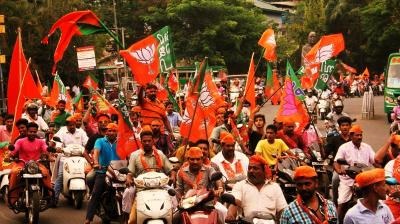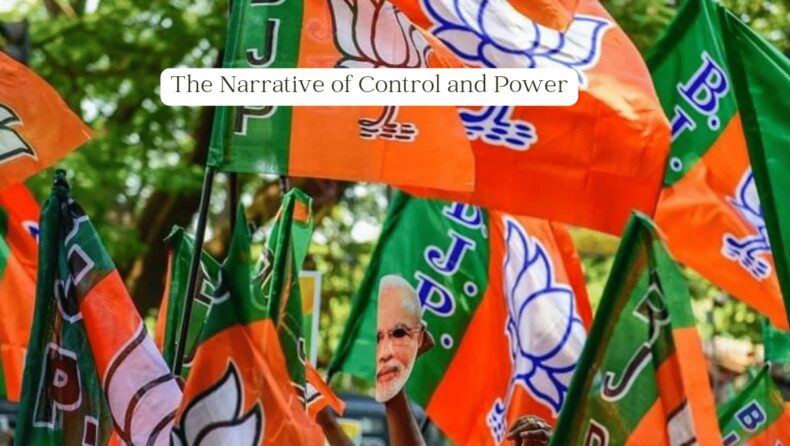The BJP is incessantly using the politics of narrative influence to propagate and get back its control of the political narrative in India.

There have been many grumblings that perhaps the BJP, which made its anti-Muslim stance a source of bliss for a significant portion of Hindus, will take action against the Popular Front of India (PFI), which is best described as the Muslim equivalent of the Rashtriya Swayamsevak Sangh but is much smaller in scope. The restraint diverts attention away from the problems that the opposition parties have consistently brought up, some of which are now being discussed in public in various areas of India.
It’s not entirely surprising that perhaps the sudden raids on the organization’s offices, arrests, and eventual ban have come after 8 years of the prime minister in power given that several civil resistance movements – the anti-CAA protests across the country or the protests against the hijab restriction in Karnataka’s academic institutions, for example – were sought to be dismissed as provocations endorsed or favoured by the PFI over the past few years.
The power and significance of influencing stories, one of humanity’s most essential collective behaviours, are twisted by governments, religious leaders, capitalists, communists, and revolutionaries as they share their messages and advance their objectives of conversion, action, and following.
BJP: Propaganda and the politics of narrative

Propaganda, in the words of political activist, social critic, and philosopher Noam Chomsky, “is to democracy what violence is to dictatorship.” Propaganda—and its several other names—serve as a fundamental component of communication, marginalisation, and power, constructed through the gaze of its perceiver and more potent today than at any point in history. It is a requisite, a weapon imposed from a hundred different directions.
“Propaganda is to a democracy what the bludgeon is to a totalitarian state.”
Naom Chomsky
To comprehend propaganda, we must first recognise that every organization—and every person, in fact—from the great controlling authority to the lone figure standing in front of the tank has an agenda, one that is frequently hidden from us, and one that is endorsed, structured, and financed by endearing caricature, recognisable icons, and blind loyalty.
The sole factor separating official propaganda from that of rebellious radical groups comprising activists and rebels, religious extremists, and cult leaders is who has developed the single most powerful narrative.
Propaganda does not operate in a vacuum, even though the modern definition of propaganda includes references to democracy and the government. It is and always has been in opposition to, influenced by, and parodied by the messaging employed by those same movements that oppose them.
Similarly, the tactics of the BJP of enforcing a singular heightened dominant narrative of Hindutva incorporated with politics of power is amassing a wider audience. This leaves a void for the stories of the marginalised, oppressed, invisibilized and any apparent counter-narrative that can challenge this larger dominant narrative that over time assumes a normal stance. The single story, and this very single story that is exclusivist in nature and dangerous then limit any possibility of an inclusivist, alternate, and contrary to what the BJP has been propagating. This is the very danger that Chimamanda Ngozi Adichie, in her quote, has very rightly warned us about.
“The single story creates stereotypes, and the problem with stereotypes is not that they are untrue, but that they are incomplete. They make one story become the only story.”
Chimamanda Ngozi Adichie
BJP: The exercise of power and influence

The timing of the ban, however, couldn’t have been more favourable for the Modi-led BJP, which takes great pleasure in establishing the political agenda with its skilled PR apparatus and compliant media. The BJP has been unable to seize power in the political discourse for almost three months.
Even if Congress is mired in turmoil as a result of internal rivalries, it has nonetheless managed to make headlines. Initially, the Udaipur Chintan Shivir slightly earlier this year gave off strong signs that perhaps the grand-old party was planning to restructure itself and take the forefront in the opposition in the future. After more than 20 years, the party then prepared for the election of a non-Gandhi president.
More significantly, the all-out onslaught on the Sangh Parivar and the Modi government by the pan-Indian Bharat Jodo Yatra has drawn attention. Rahul Gandhi has up to this point led the long march with an unexpected amount of enthusiasm, focusing on the issues of growing social polarisation, over-centralization of power, and rising inequality under the Modi regime. The BJP’s fear was evident in the way it manoeuvred to steal Congress MLAs in Goa, in its rhetorical sparring with the Congress nearly every day over trivial issues, and even in its campaign against Rahul Gandhi’s T-shirt during the Yatra. None of these assaults, though, were successful or had the desired result. The Yatra has just grown stronger and stronger.
The concerns of the BJP have also been fueled by other opposition groups at the same time. AAP’s “Make India No. 1” campaign was introduced at roughly the same period as the Congress’ Bharat Jodo Yatra. The “Delhi Model” supposedly empowered teachers and healthcare professionals, who were highlighted as the campaign’s leaders. In a manner, Arvind Kejriwal’s campaign subtly brought attention to the neglect the health and education sectors experienced under the Modi administration.
Over the past few months, AAP has grown significantly in Gujarat and Himachal Pradesh, two states that will soon have elections. Following the BJP’s lead, AAP leaders frequently disseminated contentious recordings with government representatives in these BJP-run states, thereby drawing attention to the drawbacks of how the states were run. The AAP only reacted with increased aggression when the BJP quickly accused some of the party’s top officials in the Delhi liquor policy case, leaving little room for the party to claim that the Union government’s actions against its leaders were an attempt to prevent the party from mounting a strong defence against the saffron party.
K Chandrashekar Rao has been holding marathon press conferences to point out the Centre’s failures on different policy issues and holding Modi as the chief culprit behind Telangana’s problems. Be it the embarrassment India has had to face because of the (now suspended) BJP spokesperson Nupur Sharma’s Islamophobic comments, the TRS leaders have been at the forefront of mounting the sharpest attack on the BJP’s rule among opposition parties.
BJP’s biggest setback came when ally Nitish Kumar joined hands with his arch-rival Lalu Prasad Yadav in Bihar. The BJP’s top leadership hurriedly formed committees to target seats where the BJP lost the polls in 2019. A chunk of these seats are in southern India, while a significant number are placed in states like Odisha, West Bengal and Bihar.
The ban on PFI seems to be a desperate attempt to refocus the political conversation on the polarising Hindu-Muslim issue that the BJP endorses. If the BJP had been sincere about curbing fundamentalist inclinations in India, it would have dealt with groups like Vishva Hindu Parishad and Bajrang Dal in a similar manner.
However, the PFI has emerged as a convenient scapegoat to divert attention away from the problems that the opposition parties have been bringing up. The BJP has once again implemented the ban on PFI as part of a tried-and-true political strategy to counteract the anti-incumbency sentiment that is likely to surface in the approaching state and federal elections, despite being repetitive and unimaginative.
The BJP will revert to its strategy of Hindu consolidation while the opposition parties focus on concerns like a stagnating economy, rising intercommunal strife, and power centralization. Nonetheless, it will cling to its single dominant narrative of control and power, but the question is how inclined are we to formulate a story that includes us all?












